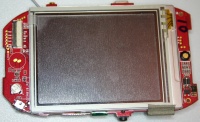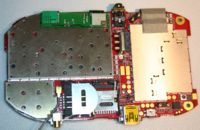Introduction
From Openmoko
m (Introduction - fixme added) |
|||
| Line 1: | Line 1: | ||
::FIXME: Write short introduction here, make few images, ... just short briefing for anybody who came for the first time, no details, no specifications. | ::FIXME: Write short introduction here, make few images, ... just short briefing for anybody who came for the first time, no details, no specifications. | ||
| − | ''' | + | "The most profound technologies are those that disappear. They weave |
| + | themselves into the fabric of everyday life until they are | ||
| + | indistinguishable from it." | ||
| + | |||
| + | Mark Weiser wrote those words almost 15 years ago in a Scientific | ||
| + | American article titled, "The Computer for the 21st Century." In it, he | ||
| + | coined the term "ubiquitous computing", and proposed a set of ground | ||
| + | rules for devices of the 21st century. | ||
| + | |||
| + | Temporally, we're here. Technologically, we're close. But everyone | ||
| + | still seems to be talking about ubiquitous computing like a mirage on | ||
| + | desert road: it's always the same distance away. Sometimes looking at | ||
| + | common every day objects with a fresh perspective yields interesting | ||
| + | new ideas. Today we're going to propose that the foundation for | ||
| + | ubiquitous computing is already here. All that is stopping us from | ||
| + | going forward is change of context. | ||
| + | |||
| + | Almost everyone we know has a mobile phone. Mobile phones have become | ||
| + | part of the fabric of everyday life. Does this mean that the mobile | ||
| + | phone is the ubiquitous computing device we've all waited for? | ||
| + | Currently, no. But with a subtle change we would argue, yes. | ||
| + | |||
| + | Mobile phones are closed environments created with a mobile context in | ||
| + | mind. But this concept is limiting; a mobile phone has the potential | ||
| + | to be a platform that can do anything that a small computer with | ||
| + | broadband access can do. If mobile phones were based on open platforms, | ||
| + | they would have the potential to bring computing to people in a ways | ||
| + | traditional computers cannot. Mobile phones can become ubiquitous | ||
| + | computers. | ||
| + | |||
| + | Ubiquitous computing, however, does not simply mean computers that can | ||
| + | be carried to work, to the home, to the beach, and to the movies. | ||
| + | Ubiquitous computers must know where they are, and then must be able to | ||
| + | merge into the environment. | ||
| + | |||
| + | We put GPS functionality into the Neo1973, because when your phone | ||
| + | simply knows its location, it can adapt its behavior in significant | ||
| + | ways without even a hint of artificial intelligence. | ||
| + | |||
| + | How can devices disappear into the background? To be honest, we have | ||
| + | far more questions than answers here. But do we know what is needed for | ||
| + | exploring this idea. Developers must have unrestricted access to | ||
| + | hardware at all times. Being able to control the microphone, for | ||
| + | example, will allow phones to sense ambient noise. A simple program | ||
| + | could prevent your phone from ringing while you're in a conversation. | ||
| + | |||
| + | We will always try our absolute best to give you devices that are as | ||
| + | open as possible. Our goal is freeing end-users and businesses alike | ||
| + | from proprietary constraints. We're about encouraging people to modify | ||
| + | and personalize their software to support their individual needs. | ||
| + | Building products as we do, we strive to enable people to connect and | ||
| + | communicate in new and relevant ways, using their own languages and | ||
| + | their own symbols. | ||
| + | |||
| + | Our company is unconventional, We openly share our roadmap. And today | ||
| + | we're going to share it with you. (Hopefully, by now, there isn't a | ||
| + | single person left on this list who thinks we're conventional ;-) | ||
| + | |||
| + | Your participation, in terms of actual code, hardware features, | ||
| + | suggestions, and usage-scenarios will shape product features of our | ||
| + | roadmap. | ||
It is based on ... | It is based on ... | ||
Revision as of 01:46, 16 February 2007
- FIXME: Write short introduction here, make few images, ... just short briefing for anybody who came for the first time, no details, no specifications.
"The most profound technologies are those that disappear. They weave themselves into the fabric of everyday life until they are indistinguishable from it."
Mark Weiser wrote those words almost 15 years ago in a Scientific American article titled, "The Computer for the 21st Century." In it, he coined the term "ubiquitous computing", and proposed a set of ground rules for devices of the 21st century.
Temporally, we're here. Technologically, we're close. But everyone still seems to be talking about ubiquitous computing like a mirage on desert road: it's always the same distance away. Sometimes looking at common every day objects with a fresh perspective yields interesting new ideas. Today we're going to propose that the foundation for ubiquitous computing is already here. All that is stopping us from going forward is change of context.
Almost everyone we know has a mobile phone. Mobile phones have become part of the fabric of everyday life. Does this mean that the mobile phone is the ubiquitous computing device we've all waited for? Currently, no. But with a subtle change we would argue, yes.
Mobile phones are closed environments created with a mobile context in mind. But this concept is limiting; a mobile phone has the potential to be a platform that can do anything that a small computer with broadband access can do. If mobile phones were based on open platforms, they would have the potential to bring computing to people in a ways traditional computers cannot. Mobile phones can become ubiquitous computers.
Ubiquitous computing, however, does not simply mean computers that can be carried to work, to the home, to the beach, and to the movies. Ubiquitous computers must know where they are, and then must be able to merge into the environment.
We put GPS functionality into the Neo1973, because when your phone simply knows its location, it can adapt its behavior in significant ways without even a hint of artificial intelligence.
How can devices disappear into the background? To be honest, we have far more questions than answers here. But do we know what is needed for exploring this idea. Developers must have unrestricted access to hardware at all times. Being able to control the microphone, for example, will allow phones to sense ambient noise. A simple program could prevent your phone from ringing while you're in a conversation.
We will always try our absolute best to give you devices that are as open as possible. Our goal is freeing end-users and businesses alike from proprietary constraints. We're about encouraging people to modify and personalize their software to support their individual needs. Building products as we do, we strive to enable people to connect and communicate in new and relevant ways, using their own languages and their own symbols.
Our company is unconventional, We openly share our roadmap. And today we're going to share it with you. (Hopefully, by now, there isn't a single person left on this list who thinks we're conventional ;-)
Your participation, in terms of actual code, hardware features, suggestions, and usage-scenarios will shape product features of our roadmap.
It is based on ...


